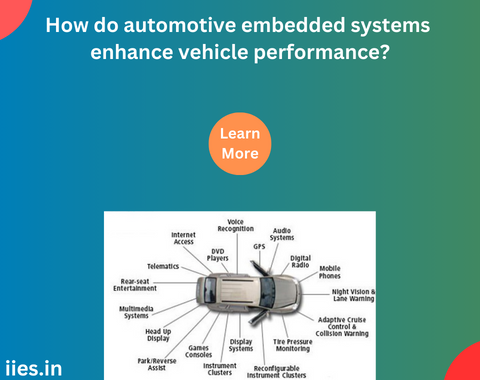
In the ever-evolving landscape of automotive technology, embedded systems have emerged as silent powerhouses that drive innovation and elevate vehicle performance to unprecedented levels. These sophisticated electronic control units (ECUs) seamlessly integrate into the fabric of modern vehicles, orchestrating a symphony of functions to optimize efficiency, safety, and overall driving experience. In this article, we will explore the multifaceted ways in which automotive embedded systems contribute to enhancing vehicle performance.
Additionally, embedded systems continuously monitor various engine parameters, such as temperature, pressure, and exhaust emissions, allowing for real-time adjustments. This adaptive control mechanism enables vehicles to operate efficiently across a wide range of driving conditions, from city traffic to open highways.
At the heart of every vehicle lies its engine, and automotive embedded systems play a pivotal role in managing and optimizing its performance. Engine control modules (ECMs) and electronic fuel injection (EFI) systems use embedded software to precisely regulate fuel injection, ignition timing, and air intake. This fine-tuned control not only enhances fuel efficiency but also ensures optimal power delivery, resulting in a smoother and more responsive driving experience.
Transmission Control Systems:
The seamless coordination between the engine and transmission is crucial for optimal vehicle performance. Automotive embedded systems manage automatic and semi-automatic transmissions, adjusting gear ratios based on driving conditions and driver input. This intelligent control ensures that the engine operates within its optimal power band, maximizing both performance and fuel efficiency.
Furthermore, embedded systems contribute to the development of advanced transmission technologies, such as dual-clutch and continuously variable transmissions. These systems enhance gear shift responsiveness, reduce energy losses, and contribute to a more enjoyable and efficient driving experience.
Advanced Driver Assistance Systems (ADAS):
In the pursuit of safer roads and reduced accidents, automotive manufacturers are integrating advanced driver assistance systems powered by embedded technology. These systems use a combination of sensors, cameras, and radar to monitor the vehicle’s surroundings and assist the driver in various ways. From adaptive cruise control to lane departure warnings, ADAS enhances both safety and performance by providing real-time information and assistance.
Embedded systems in ADAS continuously analyze data from multiple sources, enabling features like automatic emergency braking, blind-spot detection, and collision avoidance. The result is a vehicle that can react faster and more accurately to potential hazards, thereby improving overall safety and performance.
Suspension and Chassis Control:
Embedded systems also play a crucial role in optimizing a vehicle’s handling and ride comfort. Electronic control units manage suspension systems and chassis components, adjusting damping rates and ride height based on driving conditions. This dynamic control enhances stability during acceleration, braking, and cornering, contributing to improved performance and a more enjoyable driving experience.
Additionally, advanced chassis control systems, such as electronic stability control (ESC), use embedded sensors to detect and mitigate skidding or loss of traction. These systems enhance overall vehicle stability, especially in challenging road conditions, further elevating performance and safety.
Infotainment and Connectivity:
The modern driving experience extends beyond the mechanical aspects of a vehicle. Embedded systems are now an integral part of infotainment and connectivity solutions, providing drivers and passengers with a host of features that enhance convenience and enjoyment. From touchscreen displays and voice recognition systems to smartphone integration and navigation, embedded technology transforms the in-car experience.
Moreover, embedded systems enable over-the-air (OTA) updates, allowing manufacturers to continuously improve and add new features to a vehicle’s software. This dynamic connectivity ensures that vehicles remain up-to-date with the latest technologies, enhancing performance not only in terms of driving dynamics but also in terms of user experience.
Energy Management and Hybrid/Electric Vehicles:
Embedded systems play a vital role in the evolution of energy-efficient vehicles, particularly in the realm of hybrid and electric powertrains. In hybrid vehicles, embedded controllers manage the seamless transition between internal combustion engines and electric motors. These systems optimize the balance between power sources, ensuring that the vehicle operates at peak efficiency and minimizes fuel consumption.
In electric vehicles (EVs), embedded systems control the battery management system (BMS), regulating charging and discharging cycles to maximize battery life. Additionally, they manage the power delivery to the electric motors, offering precise control over acceleration and deceleration. This intelligent energy management contributes not only to enhanced vehicle performance but also to the sustainability of electric mobility.
Performance Tuning and Customization:
Embedded systems empower drivers to tailor their vehicles to suit individual preferences through performance tuning and customization options. Engine control units (ECUs) with embedded software allow enthusiasts to modify parameters like fuel injection timing, boost pressure, and throttle response. This level of customization enables drivers to unlock additional horsepower, torque, and overall performance, providing a personalized driving experience.
Automotive manufacturers also leverage embedded systems to offer different driving modes, allowing users to switch between comfort, sport, and eco-friendly settings. These modes adjust various vehicle parameters, such as suspension stiffness, steering responsiveness, and throttle mapping, offering a versatile driving experience that caters to diverse preferences and road conditions.
Predictive Maintenance:
Embedded systems contribute to proactive vehicle maintenance by implementing predictive analytics. These systems continuously monitor various components and collect data on factors like engine performance, fluid levels, and tire wear. By analyzing this data,
As automotive technology continues to advance, the role of embedded systems in enhancing vehicle performance becomes increasingly prominent. From optimizing engine efficiency to revolutionizing safety features and connectivity, these electronic marvels are the unsung heroes that propel the automotive industry forward. As we look to the future, the synergy between mechanical engineering and embedded technology will undoubtedly result in vehicles that are not only more powerful and efficient but also safer and more enjoyable to drive. In the evolving landscape of automotive innovation, the embedded systems within our vehicles are the driving force that ensures we experience the road ahead with unprecedented performance and technological sophistication.
Indian Institute of Embedded Systems – IIES